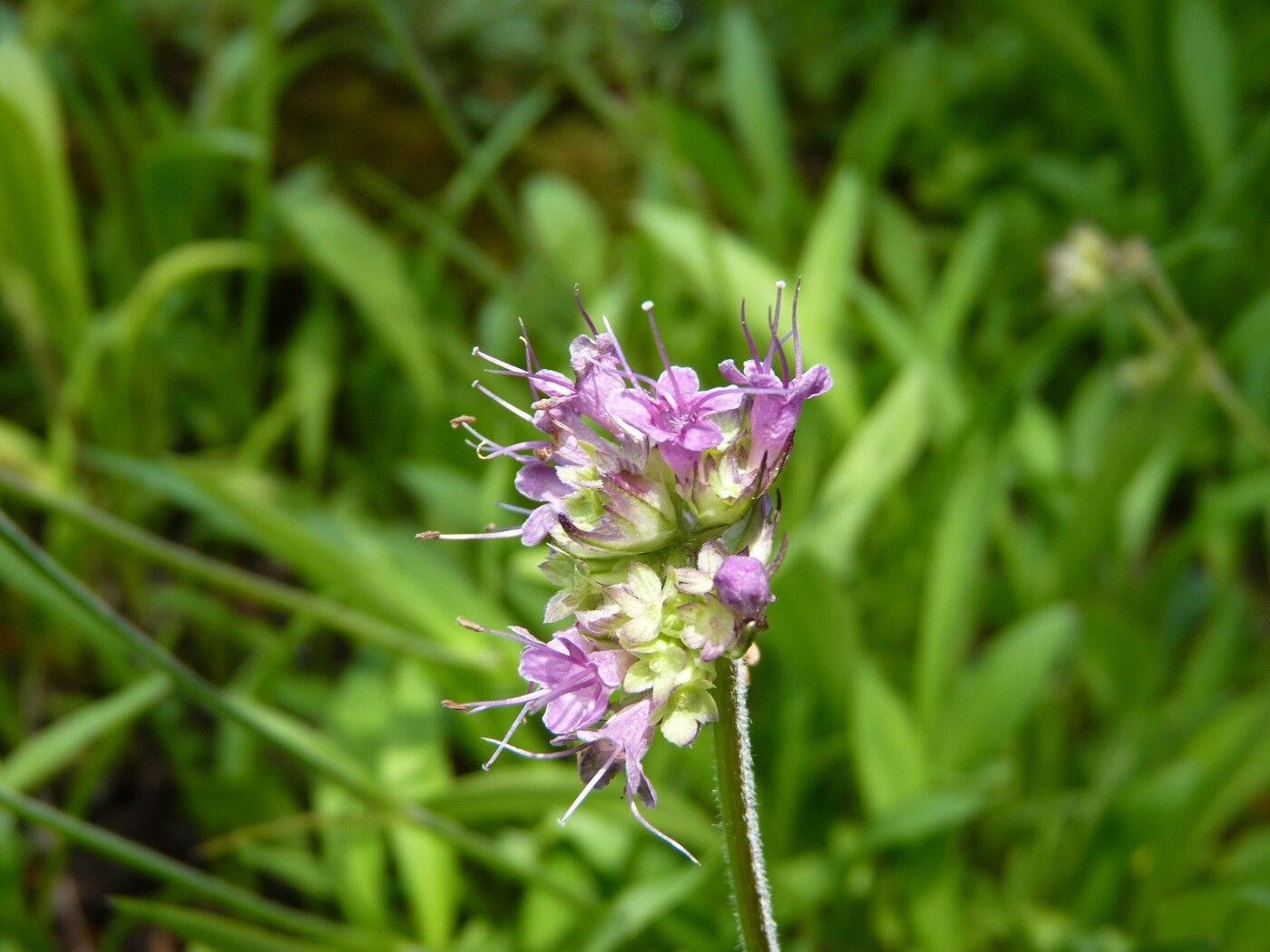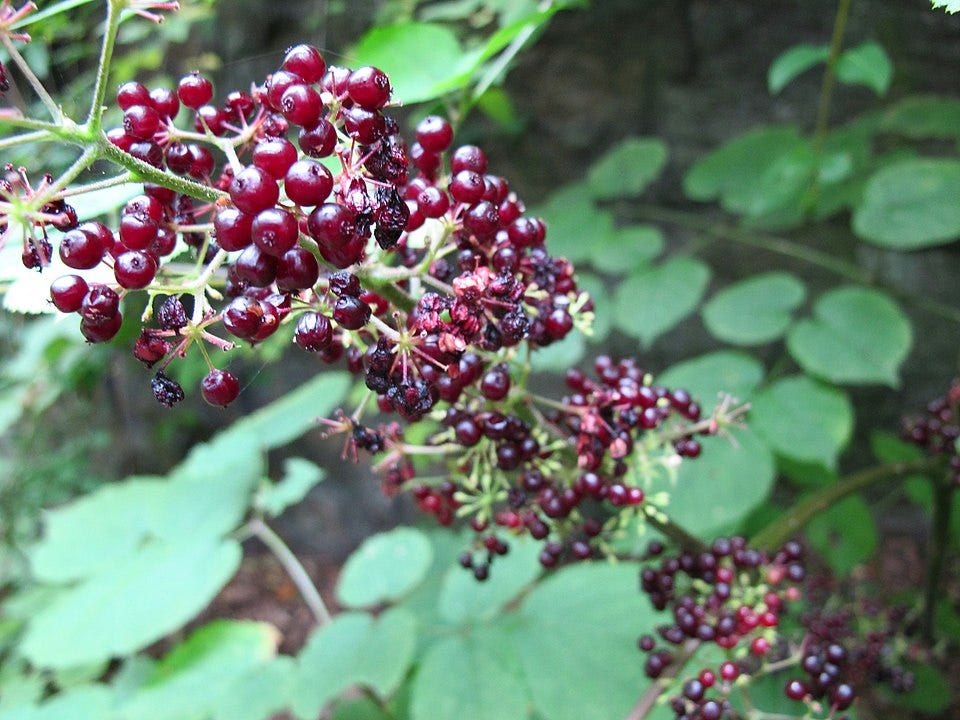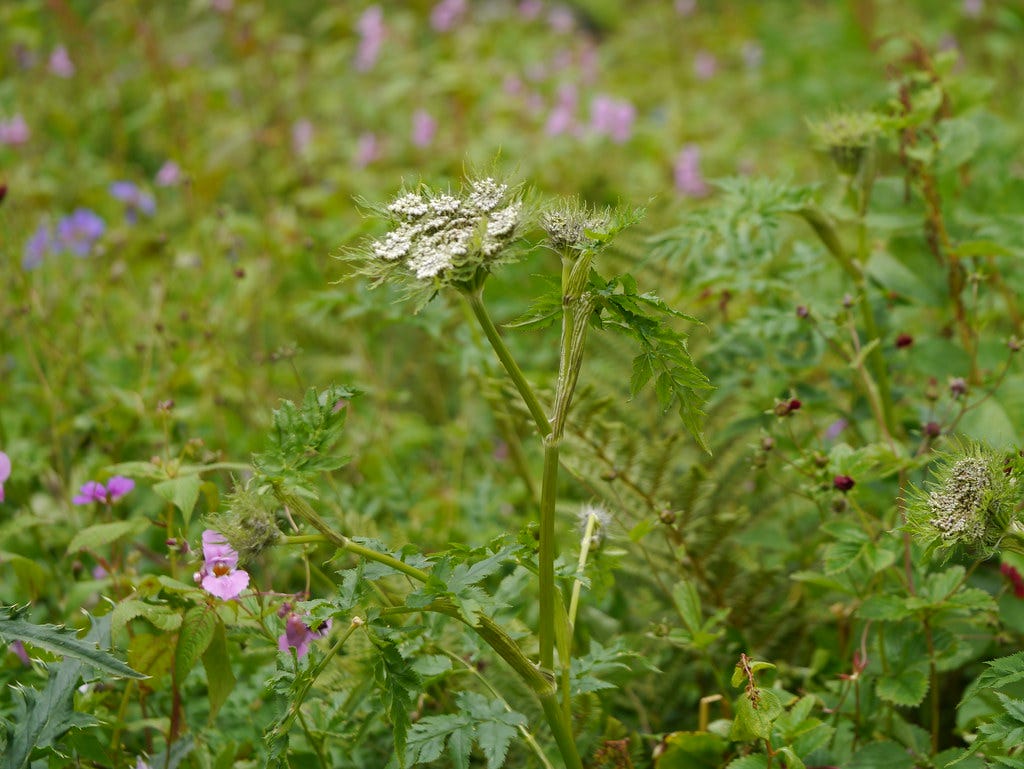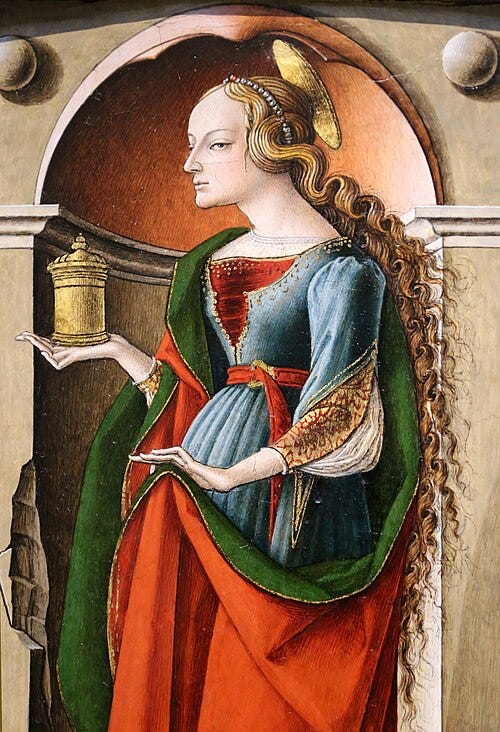ALSO KNOWN AS: nard, nardin, muskroot, Nardostachys jatamansi
How to know
Purple umbels of little showy flowers with long anthers
Two leaves like dolphins jumping from the soil on either side
A single stem on which the flower sits like a sceptre

Why was the Indian man who washed up on the red-sea coast not considered a prophet? India’s role in trade even then, about 100 years before Greece placed Cleopatra, a beautiful pawn, on one of the final thrones of ancient Egypt’s massive dynasty, was well known to some. But the seasonal monsoons made trade with the continent difficult. This man taught the Egyptians how to manage their ships in the monsoon winds and establish trade with the naturally abundant continent of India. From the highly medicinal plants native in the Himalayas, to the sweet and spicy nutmeg, pepper, and cinnamon in the south and Sri Lanka. These spices infiltrated literature and story, so they became cherished. They became sacred.
The plants of religions seem quite mythical in our minds: emerging from the mists with frankincense, myrrh, and sage. With a religious habit, the plants seem nearly untouchable. Each one has a heavy collective meaning attached to it. But many plants, in truth, have been sacred along with the dowdy rich classics brought to god-children in mangers that we know so well now. These old sacred plants live in the background of our stories. If the stories have been translated without prioritizing the plants, they lose their identities and are forgotten to time. Perhaps they even had stories of their own, but their stories are now covered over by gods or morals. The lessons are not with the plants. Spikenard is one such plant that didn’t make it through the translations. Though it became a significant plant of god. Of the semitic god. The one god that took the name of so many others. And if it was not for this man whose boat found its way an Egyptian shore, it may have stayed - where it is cherished - throughout India.
A Mountain Medicine
Spikenard is commonly crushed into an amber toned essential oil. The plant is the only one of its species and it is native to Nepal, northern India, Bhutan, and China growing way up, between 10,000 and 16,000 feet: which is why it has found home, primarily, in the Himalayas. It’s a valuable medicine that is recognized throughout this region, up into China, Tibet, and as a fundamental component in Ayurveda.
References of it in the bible and religious texts abound, but there is confusion about its name. Nard actually shows up for many plants in biblical and pre-biblical times, and it doesn’t always refer to the spikenard - even though spikenard did happen to be the most valuable of the plants. Spikenard is also a reference to lavender. The prefix “nard” resounds in my mind as something seventh grade boys used to use ad nauseam. And it took a quick search to remember that “nards” is Bevis, of Bevis and Butthead’s, word for “nuts” - and I don’t mean the legume. If this is what you’re thinking of right now, we can all have a laugh and move on.
The etymology of the word references both its value and its native regions. Its suffix “nard” has its roots in the Greek nárdos, from Hebrew: נֵרְדְּ (nērd), which, even further back, has a connection to Sanskrit नलद (nálada 'Indian spikenard'). It’s possible that the name is also connected to Naarda, an ancient Assyrian city. However, the Greeks called lavender “nardus,” which confuses which nard we’re talking about. Either way, this is not the first time we have found a city named after a plant. From the lamb's quarter capitals of the UK, to Argentinian shrubbery, Calafate. And, though this is not a city, I keep coming back to the South African Proteas’ cricket team. The value of plants is so fundamental to our every day that they define not only our landscape but the way we understand how we live our lives - our collective identity - so much so that their names are important enough to define our home. Even the “big apple” refers to the apples given to winning race horses. The name was bequeathed to the city by a sportswriter, John J. Fitz Gerald- naming a place where winners would go.
The bottom line is that there’s something about heaven written in this name.
This plant is in the honeysuckle family, which you might not know by looking at the flowers. Honeysuckle generally is a vine or a shrub that expands out in ambitious branches and twining cords. Spikenard has woody rhizomes that connect one plant to the other. Rhizomes are underground stems that erupt sporadically, into plants. Long thick tendrils that look like hair grow from the stems. But the spikenard grows like a single plant, up to three feet high, with long leaves around it. Sure, it has an extensive system of underground stems, as many plants do. But it looks like a single plant if you were to see it there, pink on the slope. One could even confuse it for a bulbed plant, like an onion or an iris, but it’s related to valerian. If you looked below the surface of the soil you’d see a mess of root The leaves are ladle shaped and opposite one another, shooting from the earth like a lily. Though if you look closely at the flower and you’ll see that same honeysuckle bell shape, with open petals, letting loose long anthers.
In the morning when the dew has settled, you can see the way the water forms like many crystal balls scrying the sun from these softened magenta flowers collected in an umbel at the head of the stalk.
The very name of the plant: jatamansi, can be translated to overgrown with human hair. Jata: means plaited, dreaded, or matted hair, both long and wide, and mani: human. Their stems are a deep purple as if they’re filled with blood, and matted with trichomes. They are crushed into a fragrant oil. Its old famous smell is of soothing moss: small, wet growth close to the earth, with a slight fire, a sweet spice within it.
Now, spikenard is critically endangered due to forest degradation and overharvesting. So harvesting for folk medicine is fraught, and yet there are businesses that still sell spikenard oils. With care, a part of the root is always let in the soil to give it time to regenerate. This is the only find of farming that spikenard has ever received in all these thousands of years. Spikenard is not cultivated, and there are no varietals that have been created. So you won’t find spikenard farms in the Himalayan mountains.
A Fragment of Eden
The presence of the spice trade in the biblical middle east is heavy handed. In some Islamic legends, it was the spikenard that was forbidden to the star crossed couple in the garden of Eden. Indeed, Jewish tradition says that spikenard was the only plant that could be taken from the garden of eden once everything had fallen. It remained as a fragment of that place, thus it is connected to scents of death like myrrh, perhaps as a way to point to an everlasting life. It was used in Egyptian burials. In the Old Testament’s Song of Songs, nard is included in a moment of rapture, as a bride descends from the mountains, like the flower itself.
Spikenard has a prominent role in the New Testament at the eve of the Last Supper. On the sixth day before passover, Mary Magdalene (or perhaps a “woman of sin” depending on which translation you read), anointed Christ’s feet with an abundance of the highly valuable spikenard, and she used her hair to dry it. I don’t know if I should be mortified by this action. But of course, why not use our hair as a tool? The apostles were horrified that all of this precious oil would be given to one person. They asked Jesus why it could not be sold for money, why should all of it be given to one doomed man. From the base of the Himalayas into Palestine and into the hands of Mary Magdalene, though this Mary may have been the Mary of Bethany. Because of this humbling act of care, Magdalene is often seen with a golden jar. In the catholic church, spikenard is a representation by Saint Joseph. In traditional Assyrian households, the oil was rubbed on the noses of Assyrian guests. However, spikenard is an intense oil, and must be diluted in order to safely apply it to the skin.
The medicinal value of spikenard has been well studied and proven. It is used primarily as a calming agent. It has a similar effect to valerian root, both being in the Caprifoliaceae family, it is related to this species, which informs its meditative cultivators of sleep. And, of course, like the honeysuckle, they are. Yet spikenard is the only plant in its genus. It stands alone. It was a treatment for epilepsy. It is anti-fungal and hepato-protective, meaning that it protects the liver, anti-parkinson's, anti-diabetic, antibacterial, anti-arrhythmic, meaning it is useful for heart health, menopausal symptoms. It helps with uterine health, promotes the secretion of estrogen and progesterone. The list really goes on and on. and it kills plant parasites called nematodes. They are used in vitro, to rats in studies by the NIH as a form of calming the animals so they can more freely make decisions, fight illnesses, and enhance memory. In addition to its many medicinal uses, spikenard was also used as a spice in foods and to flavor beer and wine in medieval Europe.
The spikenard enchants. It brings the mountains with it. It brings the scent of earth to us, and reminds us we are people of mud. Humans - of the humus soil. If Eden was anything, it was earth. Thousands of years of ritual from every culture of the old world follow spikenard, a plant that, as a medicine, upholds humanity at its best, whether it is beneath the prayer flags in the hills of Tibet or Sikkim, or at the River Jordan. Humans are species who remember: who, when their minds are calm and rested, solve problems; a species who have thrived in the highest mountains, coldest corners, and hottest and driest regions. Like the spikenard, living beside so many tribal, nomadic, pastoral, settled communities of the great Himalayas, we survive where the air is thinnest too.
myth for spikenard
Not to be confused with American spikenard. These are more shrubby, and they have umbels of white flowers.

Or Bhutkeshi. They share that same umbel at the top of the stalk. And those basal leaves that grow up and out. Their roots also look very similar. But in general these plants look more like queen anne’s lace from the top.

Forager Friendly?
No!
Sources:
https://pmc.ncbi.nlm.nih.gov/articles/PMC3510905/
https://www.sciencedirect.com/science/article/abs/pii/S0367326X23003398
https://www.starpath.com/cgi-bin/web_card/courses/glossary.pl?show_def=1080&cat=
https://pmc.ncbi.nlm.nih.gov/articles/PMC3618914/
https://temperate.theferns.info/plant/Nardostachys+jatamansi
https://www.wisdomlib.org/definition/jata
https://www.urbandictionary.com/define.php?term=nards
https://www.metmuseum.org/toah/hd/phar/hd_phar.htm
https://powo.science.kew.org/taxon/urn:lsid:ipni.org:names:859418-1
https://www.inaturalist.org/taxa/496140-Nardostachys-jatamansi
https://ayushdhara.in/index.php/ayushdhara/article/view/787
https://sabbatsandsabbaths.com/2021/06/30/lavender-the-great-nard-controversy/
https://www.youtube.com/watch?v=6V8vd7j09C8 (this video makes me feel uncomfortable in a lot of ways - but you can see the spikenard being harvested where is grows on the slopes of mountains)
https://christianity.stackexchange.com/questions/15061/what-does-spikenard-have-to-do-with-st-joseph
https://en.wikipedia.org/wiki/Spikenard
https://www.healthline.com/health/spikenard#summary
https://kingjamesbibledictionary.com/Dictionary/spikenard
https://en.wikipedia.org/wiki/Anointing_of_Jesus
https://www.sciencedirect.com/science/article/pii/S2949834123000119
https://avedaayur.com/jatamansi-nardostachys-jatamansi-wiki/
http://islandlife-inamonastery.blogspot.com/2013/04/mystery-flower.html
8 Come with me from Lebanon, my spouse, with me from Lebanon; look from the top of Amana, from the top of Senir and Hermon, from the lions’ dens, from the mountains of the leopards.
9 Thou hast ravished my heart, my sister, my spouse; thou hast ravished my heart with one of thine eyes, with one chain of thy neck.
10 How fair is thy love, my sister, my spouse! How much better is thy love than wine, and the smell of thine ointments than all spices!
11 Thy lips, O my spouse, drip as the honeycomb; honey and milk are under thy tongue, and the smell of thy garments is like the smell of Lebanon.
12 A garden enclosed is my sister, my spouse, a spring shut up, a fountain sealed.
13 Thy plants are an orchard of pomegranates with pleasant fruits, henna with spikenard,
14 spikenard and saffron, calamus and cinnamon, with all trees of frankincense, myrrh and aloes, with all the chief spices”
15 a fountain of gardens, a well of living waters, and streams from Lebanon.”
16 “Awake, O north wind, and come, thou south! Blow upon my garden, that the spices thereof may flow out. Let my beloved come into his garden and eat his pleasant fruits.”
King James Version, Song of Songs 4:13




